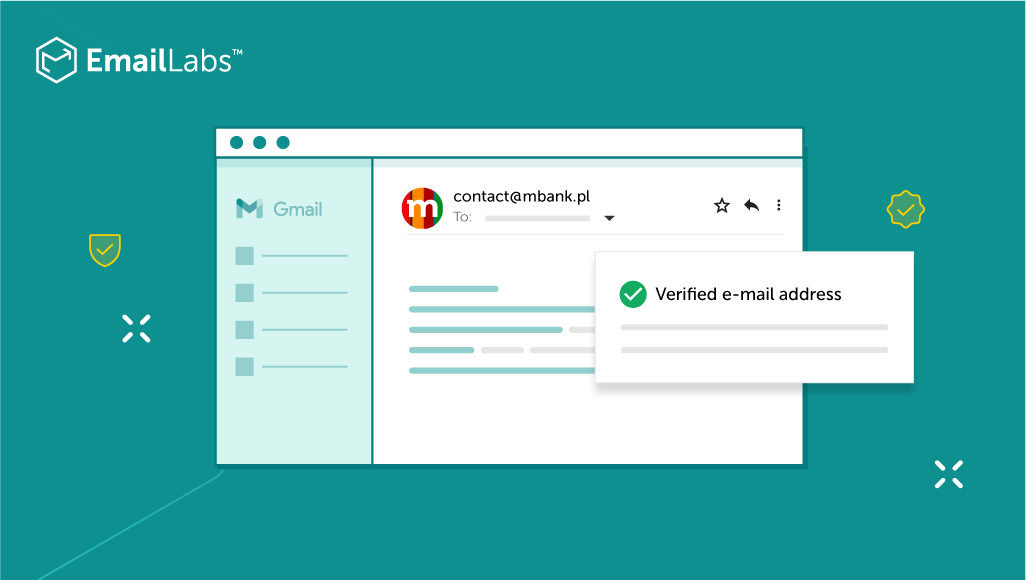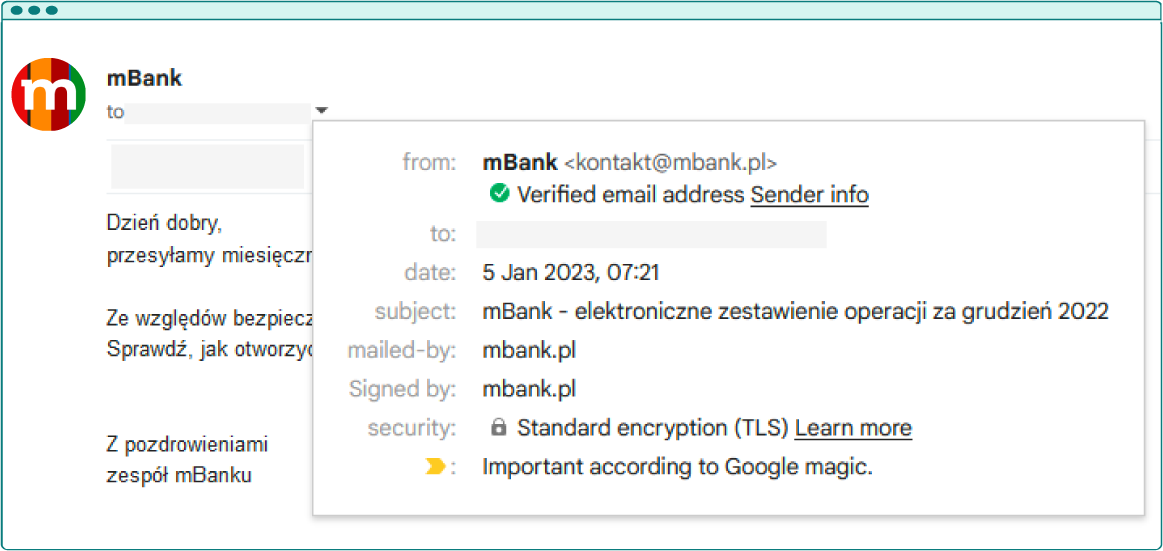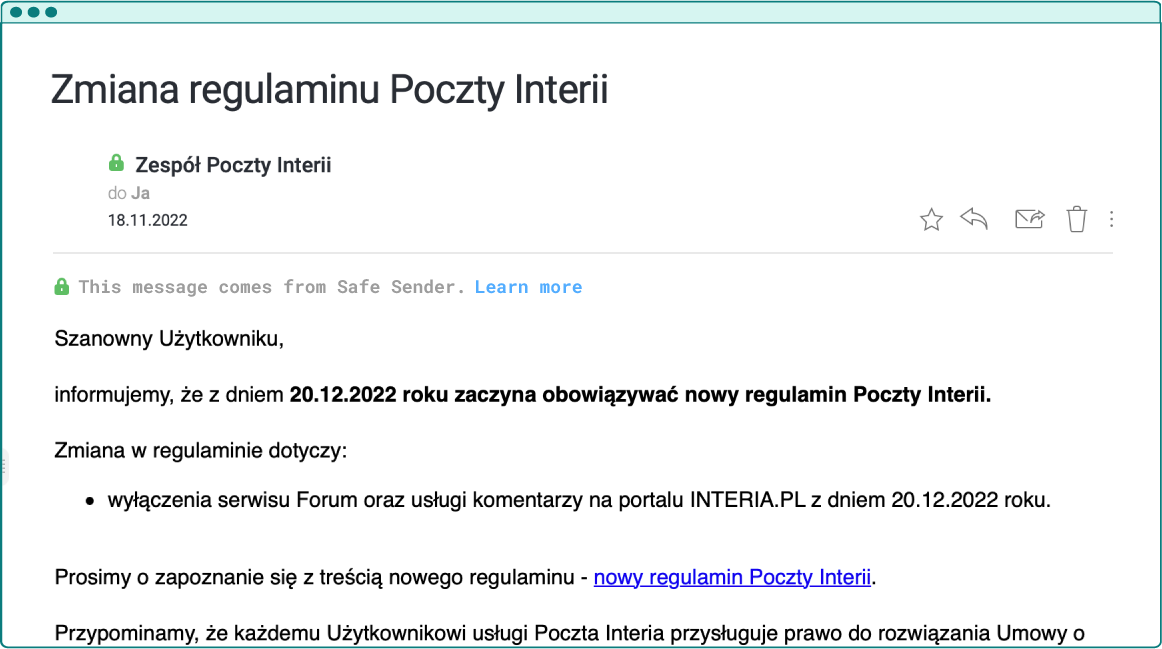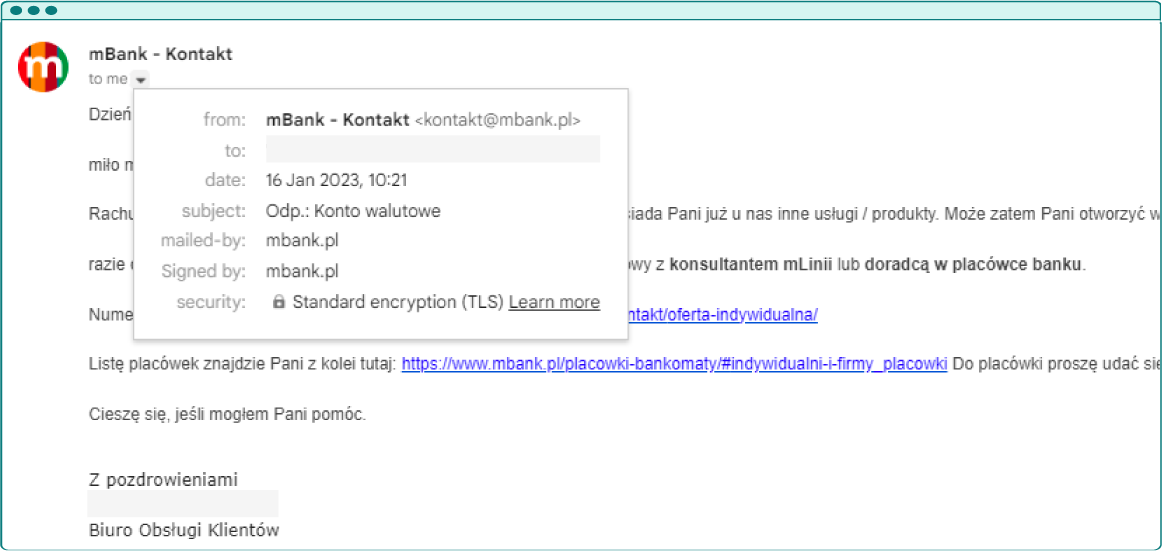Best practices, Maile transakcyjne, Transactional Emails
Best practices, Maile transakcyjne, Transactional Emails

mBank was the first bank in our country to declare war on cybercriminals’ activities and implement sender authentication in the most popular mailboxes used by their customers.
These solutions help visually distinguish genuine from forged correspondence. Both Polish (including Interia, Onet, WP/O2) and global (including Gmail) mail providers enable advanced sender authentication solutions.

Having these verified email address badges, which are visible in most popular email clients, means the message has been digitally signed using a certain security protocol, called S/MIME to be more precise.
Their proper implementation is rewarded by displaying distinctive graphics (a green shield), or the brand’s logo, next to the sender’s name in the mailbox and inside each authenticated email. This type of verification also has an impact on the brand’s reputation and message deliverability, preventing emails from ending up in spam.
” The additional security implemented by mBank as part of the fight against phishing allows message recipients to verify whether the email actually comes from this particular bank. Added safeguard, which appears in the form of graphics, is certainly a great convenience for ordinary users, thanks to which they can more easily distinguish a malicious message from a legitimate one. One should keep in mind, however, that every security measure will sooner or later be broken/dominated by cybercriminals, which is why it’s so important to constantly improve our systems and make sure they have the ‘latest’ safety features.”
Michał Błaszczak, Pentester at EmailLabs
CyberLabs #1- Phishing being one of the most popular cyber threats
The mBank Group is using EmailLabs to handle transaction emails sent to users of Paynow payment gateway. The CTO of mElements (From the mBank Group) shared his comments on the changes brought by the implementation of Email API:
“We chose EmailLabs, i.a. due to our customers’ data security,” Sebastian Sztajnert said at the time.
Today mBank goes further by launching the latest available sender authentication solutions. Characters or graphic elements allow users to easily verify the validity of communications received in most popular mobile applications or browser versions (they will not be available for Thunderbird or Outlook users).
How did we achieve the highest level of security for data storage servers? Read mElement and EmailLabs’ Case Study.
Mailbox providers require senders to have basic authentication like SPF and DKIM, without which messages will not reach users. However, besides the general solutions available to all, senders are offered access to premium features.
In the first step, sender checks ISPs’ structure in his contact list. If the vast majority of them use: WP, O2, Interia, Onet, Gmail, Yahoo, in each case these providers’ mailboxes can be configured for additional sender security.
Have you noticed that next to some email senders on your inbox you can see the badge of a verified email address?
Maximize your email deliverability and security with EmailLabs!
WP, O2 have a Trusted Sender standard, Onet has a Verified Sender service, Interia gives you the option to run a Safe Sender and have the logo appear in your inbox.

You’ll see a green padlock icon and a notification in the message from the Safe Sender.
Gmail as well as Yahoo, and also Onet Mail recently, while by honoring the BIMI solution, with verified senders they display both on the mail listing and in the emails itself, notarized brand logos.

mBank communication secured by the BIMI standard.
The mailbox providers are responsible for the sender’s technical authentication settings. By verifying their email communication activities, they have the right to reject enabling the service if these practices raise any concerns. Most additional solutions also come at an extra cost and require a series of steps. To facilitate these steps, you can use EmailLabs – all of them are available in a single agreement.
Maximize your email deliverability and security with EmailLabs!
Authenticated senders like Verified Sender, Safe Sender, BIMI or S/MIME are proven solutions for the most recognizable brands, especially those operating in the banking, fintech, courier services, e-commerce, retail or advertising industries.
The increasing number of phishing attacks each year, and the projection that this trend will continue to escalate, aren’t likely to astonish anyone. This can be attributed, in part,...
With the emergence of the Covid-19 pandemic, many brands have been challenged to adapt in a short period to the changed reality and new consumer attitudes. That meant reorganizing...
If you’re sending more than 5,000 emails a day, you need to pay attention. Microsoft just dropped a major announcement that’s going to change how your emails get delivered....
Best practices, Email Authentication
Email headers may seem like a cloud of confusion, but fear not! In this ultimate guide, we will break down email headers and make them crystal clear. We’ll start...
Does your inbox feel like a never-ending to-do list? Are you spending more time sorting emails than actually working? You’re not alone. Millions of professionals struggle with email overload,...
We are delighted to announce that Vercom S.A., the company behind the EmailLabs project, has successfully completed the ISO 22301 certification process. This significant achievement underscores our commitment to...
EmailLabs, as part of the Vercom group, proudly announces its full commitment to aligning its ICT services with the latest cybersecurity standards. In response to dynamically changing regulations, the...
Best practices, Compliance & Security
As we step closer to a digitally connected future, ensuring inclusivity in our marketing strategies is more important than ever. Email, a cornerstone of digital communication, must evolve to...
We are pleased to announce that MessageFlow, a product from the Vercom S.A. group, has received the prestigious CSA (Certified Senders Alliance) Certification. This recognition not only underscores the...
The increasing number of phishing attacks each year, and the projection that this trend will continue to escalate, aren’t likely to astonish anyone. This can be attributed, in part,...
With the emergence of the Covid-19 pandemic, many brands have been challenged to adapt in a short period to the changed reality and new consumer attitudes. That meant reorganizing...
If you’re sending more than 5,000 emails a day, you need to pay attention. Microsoft just dropped a major announcement that’s going to change how your emails get delivered....
Best practices, Email Authentication
Email headers may seem like a cloud of confusion, but fear not! In this ultimate guide, we will break down email headers and make them crystal clear. We’ll start...
Does your inbox feel like a never-ending to-do list? Are you spending more time sorting emails than actually working? You’re not alone. Millions of professionals struggle with email overload,...
We are delighted to announce that Vercom S.A., the company behind the EmailLabs project, has successfully completed the ISO 22301 certification process. This significant achievement underscores our commitment to...
EmailLabs, as part of the Vercom group, proudly announces its full commitment to aligning its ICT services with the latest cybersecurity standards. In response to dynamically changing regulations, the...
Best practices, Compliance & Security
As we step closer to a digitally connected future, ensuring inclusivity in our marketing strategies is more important than ever. Email, a cornerstone of digital communication, must evolve to...
We are pleased to announce that MessageFlow, a product from the Vercom S.A. group, has received the prestigious CSA (Certified Senders Alliance) Certification. This recognition not only underscores the...
The increasing number of phishing attacks each year, and the projection that this trend will continue to escalate, aren’t likely to astonish anyone. This can be attributed, in part,...
We are delighted to announce that Vercom S.A., the company behind the EmailLabs project, has successfully completed the ISO 22301 certification process. This significant achievement underscores our commitment to...
Do you ever wonder how many people actually open the emails you send? Knowing the number of people who open your emails is essential for understanding the effectiveness of...
Gmail has become a cornerstone of modern email communication, offering a dynamic platform that caters to both personal and professional needs. Since its inception in 2004, Gmail has consistently...
EmailLabs, as part of the Vercom group, proudly announces its full commitment to aligning its ICT services with the latest cybersecurity standards. In response to dynamically changing regulations, the...
Email deliverability is a cornerstone of effective digital marketing. It ensures that your carefully crafted messages reach the intended recipients’ inboxes rather than being relegated to spam folders. Google...
If you’re sending more than 5,000 emails a day, you need to pay attention. Microsoft just dropped a major announcement that’s going to change how your emails get delivered....
Best practices, Email Authentication
Email headers may seem like a cloud of confusion, but fear not! In this ultimate guide, we will break down email headers and make them crystal clear. We’ll start...
Does your inbox feel like a never-ending to-do list? Are you spending more time sorting emails than actually working? You’re not alone. Millions of professionals struggle with email overload,...
Apple Mail, Email Marketing, Gmail
Efficient email management has become a necessity in today’s digital world. To address this need, email services categorize incoming messages into different tabs or folders, helping users streamline their...
We are delighted to announce that Vercom S.A., the company behind the EmailLabs project, has successfully completed the ISO 22301 certification process. This significant achievement underscores our commitment to...
Do you ever wonder how many people actually open the emails you send? Knowing the number of people who open your emails is essential for understanding the effectiveness of...
Gmail has become a cornerstone of modern email communication, offering a dynamic platform that caters to both personal and professional needs. Since its inception in 2004, Gmail has consistently...
EmailLabs, as part of the Vercom group, proudly announces its full commitment to aligning its ICT services with the latest cybersecurity standards. In response to dynamically changing regulations, the...
Email deliverability is a cornerstone of effective digital marketing. It ensures that your carefully crafted messages reach the intended recipients’ inboxes rather than being relegated to spam folders. Google...
If you’re sending more than 5,000 emails a day, you need to pay attention. Microsoft just dropped a major announcement that’s going to change how your emails get delivered....
Best practices, Email Authentication
Email headers may seem like a cloud of confusion, but fear not! In this ultimate guide, we will break down email headers and make them crystal clear. We’ll start...
Does your inbox feel like a never-ending to-do list? Are you spending more time sorting emails than actually working? You’re not alone. Millions of professionals struggle with email overload,...
Apple Mail, Email Marketing, Gmail
Efficient email management has become a necessity in today’s digital world. To address this need, email services categorize incoming messages into different tabs or folders, helping users streamline their...
We are delighted to announce that Vercom S.A., the company behind the EmailLabs project, has successfully completed the ISO 22301 certification process. This significant achievement underscores our commitment to...